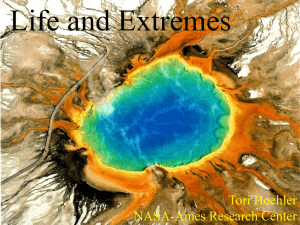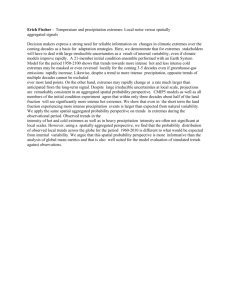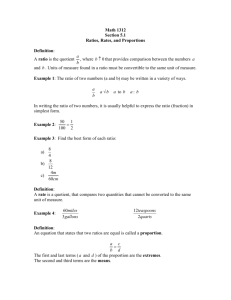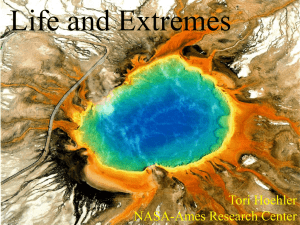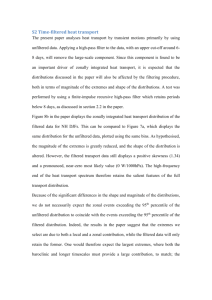MAS8306: Environmental Extremes
advertisement
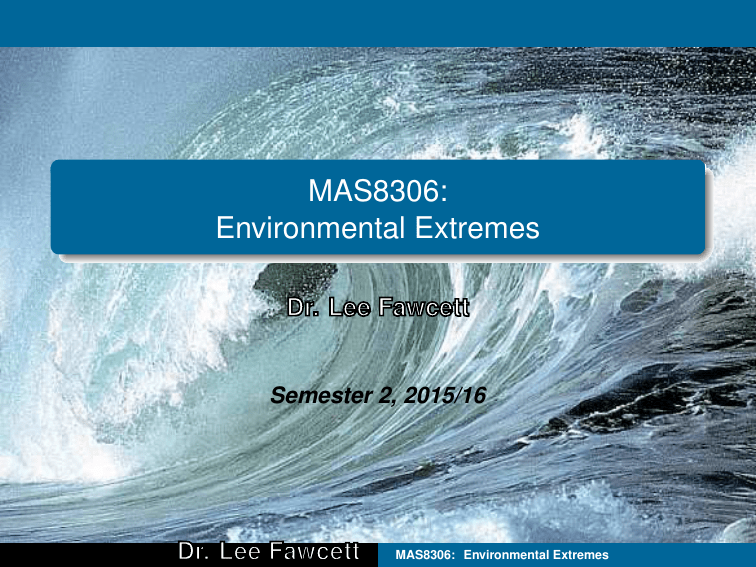
MAS8306: Environmental Extremes Semester 2, 2015/16 MAS8306: Environmental Extremes Contact details My name: Lee Fawcett Office: Room 2.07 Herschel Building Phone: 0191 208 7228 Email: lee.fawcett@ncl.ac.uk www: www.mas.ncl.ac.uk/∼nlf8 MAS8306: Environmental Extremes Timetable and Administrative arrangements Lectures are in KGVI LT5 (Herschel TR4 after Easter) on Tuesdays at 2pm and Daysh G.05 on Wednesdays at 12 noon. Tutorial time will be given in some lectures. I will notify you in advance if a lecture/part of a lecture is to be replaced with tutorial/reading/self–study time – these slots will be optional. Computer practicals: Mondays at 9am (Chart PC cluster, Barbara Strang). These will happen in teaching weeks 3 and 6 and will help you with the assignments. Office hours: Mondays 1pm, Tuesdays 1pm. MAS8306: Environmental Extremes Assessment and deadlines Extremes (LF) Longitudinal (PJA) Assessment Homework 1 Homework 2 Homework 3 Mid–semester test Exam (half of MAS8306) Homeworks Mid–semester test Exam (half of MAS8306) Weighting 10% total 5% 35% 10% 5% 35% 100% Date/Deadline 4pm, Thu 25 Feb 4pm, Thu 10 Mar 4pm, Thu 12 May 12–1, Wed 13 Apr May/June See PJA See PJA May/June MAS8306: Environmental Extremes Other stuff Notes (with gaps) will be handed out in lectures – you should fill in the gaps during lectures. A summarised version of the notes will be used in lectures as slides. – Listen and learn – Write down – Announcements These notes and slides will be posted on the course website after each section is finished, along with any other course material – such as problems sheets, model solutions to assignment questions, supplementary handouts etc. MAS8306: Environmental Extremes Other stuff The course website can be found via the “Additional teaching information” link on the School’s webpage, or directly via: http://www.mas.ncl.ac.uk/∼nlf8 Please check your University email account regularly, as course announcements will often be made via email. MAS8306: Environmental Extremes History of this course MAS369: 1995–2000 – Dr. Mark Dixon – now the multi–millionaire founder of sports betting company ATASS MAS369: resurrected in 2002 for one year only – Dave Walshaw (see OHP slides...) Course: Reading module for Stage 3 MMath/MMathStat students (and select BSc students!) MAS369 out–of–date with current research – now a new, more advanced “topic” in MAS8304/6 MAS8306: Environmental Extremes Aims of this course To expose you to an area of active research in the School To expose you to a very hands–on, applied area of Statistics To give you a firm grounding in the basics of techniques for analysing environmental data... ... but also to bring you bang up–to–date with current research ideas Quite a níche area of research, but along the way we will have to get to grips with some more generic statistical tools Independent project: will be based on a recently–published article in the field MAS8306: Environmental Extremes A word on pre–requisite knowledge I will not assume any knowledge past 2nd year Statistics courses (MAS2302) We will make use of some techniques from these courses (e.g. maximum likelihood, the delta method, likelihood ratio tests) – these will be quickly reviewed, as–and–when they make an appearance, but you may want to consult your old notes for further details Some basic Statistical Modelling techniques will be used, but will be fully demonstrated if they go beyond MAS2302/3320. MAS8306: Environmental Extremes Let’s start with some (non–mathematical) background and motivation... MAS8306: Environmental Extremes Chapter 1 Background and motivation MAS8306: Environmental Extremes 1.1 Introduction Finally, there is almost a global consensus amongst scientists that our planet’s climate is changing. Evidence for climatic change has been collected from a variety of sources, some of which can be used to reconstruct the earth’s changing climates over tens of thousands of years. Reasonable complete global records of the earth’s surface temperature since the mid–1800’s indicate a positive trend in the average annual temperature, and maximum annual temperature, most noticeable at the earth’s poles. MAS8306: Environmental Extremes 1.1 Introduction MAS8306: Environmental Extremes 1.1 Introduction MAS8306: Environmental Extremes 1.1 Introduction Glaciers are considered the most sensitive indicators of climate change. As the earth warms, glaciers retreat and ice sheets melt. Over the last 30 years or so this has resulted in a gradual increase in sea and ocean levels. MAS8306: Environmental Extremes 1.1 Introduction Retreat of Lyall Glacier, California MAS8306: Environmental Extremes 1.1 Introduction MAS8306: Environmental Extremes 1.1 Introduction Consequences Irreversible changes to sea and ocean ecosystems Threat of flooding to low–lying inhabited areas of land Effect on the earth’s weather systems – for example: – Larger amount of warmer water in North Atlantic Ocean −→ Stronger, more frequent tropical storms/hurricanes (e.g. Katrina, Sandy) – More frequent tropical cyclones in the Indian Ocean/Pacific Ocean (e.g. Bangladesh, India, Malaysia) – Flooding in the U.K. – 2012 being the second wettest year on record MAS8306: Environmental Extremes 1.1 Introduction The world’s changing climate is also likely to give rise to an increase in the frequency of periods of intense heat and drought. Though some parts of the world are familiar with the effects of extreme heat, we are beginning to see an increase in severe hot spells in more temperate latitudes – for example, the 2003 European heatwave which resulted in thousands of deaths. In drier parts of the world, this has resulted in an increase in devastating forest fires (New South Wales and Victoria), and in developing counties an increase in famine. MAS8306: Environmental Extremes 1.2 Examples: Hurricane Katrina MAS8306: Environmental Extremes 1.2 Examples: Hurricane Katrina Some facts Category 5 Hurricane (Category 3 when it made landfall) Killed 1833 people Caused $108 bn worth of damage Most damage/loss of life caused by storm surge Storm surge reached nearly 14 feet above sea level Lowest air pressure 902 mb Political controversy Billed as the “storm of the century” MAS8306: Environmental Extremes 1.2 Examples: Hurricane Katrina MAS8306: Environmental Extremes 1.2 Examples: Hurricane Katrina MAS8306: Environmental Extremes 1.2 Examples: Hurricane Katrina MAS8306: Environmental Extremes 1.2 Examples: Hurricane Katrina MAS8306: Environmental Extremes 1.2 Examples: Hurricane Sandy MAS8306: Environmental Extremes 1.2 Examples: Hurricane Sandy MAS8306: Environmental Extremes 1.2 Examples: Hurricane Sandy MAS8306: Environmental Extremes 1.2 Examples: Hurricane Sandy MAS8306: Environmental Extremes 1.2 Examples: Hurricane Sandy Devastated parts of the Caribbean, Mid–Atlantic and New Jersey/New York Tenth hurricane of busy 2012 hurricane season Caused an estimated $ 65.6 bn worth of damage Second costliest hurricane in US history (after Katrina) Killed 253 people Sea surge reached 10 feet MAS8306: Environmental Extremes 1.2 Examples: Hurricane ????, USA, 2016? MAS8306: Environmental Extremes 1.2 Examples: Extreme weather in the UK The UK is no stranger to changing climate. 2012 was the second wettest year in the UK since records began 1998, 1999, 2000, 2002, 2008 and 2012 in the top ten wettest years Examples: – Flash–flooding in Glasgow (2002) – Flooding in Boscastle (2004) – Entire UK (2007, 2008, 2009, 2012) – including severe flash–flooding in Newcastle in June 2012 MAS8306: Environmental Extremes 1.2 Examples: Flooding in Newcastle, June 2012 MAS8306: Environmental Extremes 1.2 Examples: Flooding in Newcastle, June 2012 MAS8306: Environmental Extremes 1.2 Examples: Flooding in Newcastle, June 2012 MAS8306: Environmental Extremes 1.2 Examples: Flooding in Newcastle, June 2012 MAS8306: Environmental Extremes 1.2 Examples: The Great North Sea Flood, 1953 MAS8306: Environmental Extremes 1.2 Examples: The Great North Sea Flood, 2025? MAS8306: Environmental Extremes 1.2 Examples: The Great Storm of 1987 15/16 October 1987 Killed 22 people in England/France Met Office criticism: – Recent cutbacks – no weather ship in the Southwest Approaches – Weather presenter Michael Fish told the British public not to worry, and that there is no “hurricane on the way” MAS8306: Environmental Extremes 1.2 Examples: Tornadoes in Birmingham, 2005 MAS8306: Environmental Extremes 1.2 Examples: Tornadoes in Birmingham, 2005 MAS8306: Environmental Extremes 1.2 Examples: Heatwaves and drought The world’s changing climate is also likely to give rise to an increase in the frequency of periods of intense heat and drought. Not a new thing for some parts of the world! Hot spells becoming more frequent in other areas: Heatwaves in Europe 2003, 2006 Increase in frequency of forest fires in parts of Europe, Canada and Australia MAS8306: Environmental Extremes 1.3 Why statistical modelling? Statistical modelling of extreme weather has a very practical motivation: reliability — — anything we build needs to have a good chance of surviving the weather/environment for the whole of its working life. This has obvious implications for civil engineers and planners. MAS8306: Environmental Extremes 1.3 Why statistical modelling? For example, in the context of some of the examples we have looked at so far, they need to know: How tall to build sea walls/flood defences – for example – – the levees surrounding New Orleans; – flood defences in New York that were breached during Superstorm Sandy; – river and sea defences in the U.K.; How strong to make buildings – for example, in the U.K. the British Standards Institute specifies that new structures need to be strong enough to withstand the “Fifty year wind speed”; How tall to build reservoir dams; How much fuel to stockpile. MAS8306: Environmental Extremes 1.3 Why statistical modelling? This motivates the need to estimate what the: Highest tide; Heaviest rainfall; Strongest wind; most severe cold spell; will be over some fixed period of future time. MAS8306: Environmental Extremes 1.3 Why statistical modelling? The only sensible way to do this is to use data on the variable of interest (wind, rain etc.) and fit an appropriate statistical model. The models themselves are motivated by asymptotic theory, and this will be our starting point in Chapter 2. Before this, let’s start at a very basic level, and think about why we need statistical models at all. MAS8306: Environmental Extremes 1.4 Simple example: sea surges at Wassaw Island Wassaw Island is a barrier island off the southeast coast of Georgia, in the USA. Any hurricanes about to make landfall on the mainland often hit such barrier islands first, substantially subduing the impending storm. Sea surge data is collected at Wassaw Island every hour; the data shown below are the extracted annual maxima for the years 1955–2004. 8.5 9.6 8.3 9.5 11.1 8.9 9.3 8.1 7.4 12.7 9.1 8.7 7.3 7.3 11.5 8.9 9.0 6.8 10.2 11.8 8.4 8.8 6.7 10.3 12.6 9.7 8.9 7.3 10.4 13.0 9.1 8.9 7.6 8.8 10.5 9.6 12.2 8.2 9.7 10.5 8.7 7.8 8.6 10.0 10.0 MAS8306: Environmental Extremes 9.3 7.7 9.8 10.8 9.4 1.4 Simple example: sea surges at Wassaw Island 1. Civil engineers are interested in various exceedance probabilities. For example, suppose they need to know the probability that sea–surge will exceed 8.75, 11.25 and 14 feet. Use the data to estimate these probabilities. MAS8306: Environmental Extremes Solution Estimating these probabilities using relative frequencies gives: Pr(sea–surge exceeds 8.75 feet) = 33 = 0.66 50 Pr(sea–surge exceeds 11.25 feet) = 6 = 0.12 50 Pr(sea–surge exceeds 14 feet) = 0 = 0. 50 Do you really think it’s impossible for sea–surge to exceed 14 feet? MAS8306: Environmental Extremes Solution 8.5 9.6 8.3 9.5 11.1 8.9 9.3 8.1 7.4 12.7 9.1 8.7 7.3 7.3 11.5 8.9 9.0 6.8 10.2 11.8 8.4 8.8 6.7 10.3 12.6 9.7 8.9 7.3 10.4 13.0 9.1 8.9 7.6 8.8 10.5 9.6 12.2 8.2 9.7 10.5 8.7 7.8 8.6 10.0 10.0 MAS8306: Environmental Extremes 9.3 7.7 9.8 10.8 9.4 Solution Estimating these probabilities using relative frequencies gives: Pr(sea–surge exceeds 8.75 feet) = 33 = 0.66 50 Pr(sea–surge exceeds 11.25 feet) = 6 = 0.12 50 Pr(sea–surge exceeds 14 feet) = 0 = 0. 50 Do you really think it’s impossible for sea–surge to exceed 14 feet? MAS8306: Environmental Extremes 1.4 Simple example: sea surges at Wassaw Island 2. How high should state authorities build flood defences at the nearby city of Savannah if they want to protect the city against the sea–surge they would expect to see: (i) Once every 10 years; (ii) Once every hundred years? MAS8306: Environmental Extremes Solution (1/2) In ascending numerical order, the data are: 6.7 8.2 8.9 9.6 10.5 6.8 8.3 8.9 9.6 10.5 7.3 8.4 8.9 9.7 10.8 7.3 8.5 9.0 9.7 11.1 7.3 8.6 9.1 9.8 11.5 7.4 8.7 9.1 10.0 11.8 7.6 8.7 9.3 10.0 12.2 7.7 8.8 9.3 10.2 12.6 7.8 8.8 9.4 10.3 12.7 8.1 8.9 9.5 10.4 13.0 Since we have annual data, an intuitive argument would be to find the value which has 10% of the data above it. We have 50 observations, and 10% of these observations exceed 11.7999 ≈ 11.8 feet. MAS8306: Environmental Extremes Solution (2/2) For the level which is exceeded once every hundred years, we would need the value which has 1% of the data above it. We don’t have enough data – we only have 50 years of data, and we want the value that is exceeded once every hundred years! 1% of 50 = 1/2 an observation! MAS8306: Environmental Extremes Further comments We have no chance of producing any sort of estimate that goes beyond the timeframe of our collected data – however, it is vitally important for engineers that we do estimate such quantities! We are trying to estimate events more extreme than have ever occurred before – an impossible task? Not impossible... To extrapolate beyond the range of our observed data, we need a statistical model that we can assume is valid for our observed extremes and beyond. This is where extreme value theory comes in! MAS8306: Environmental Extremes

